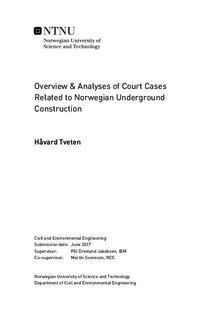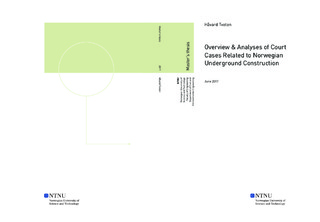| dc.description.abstract | There is a consensus in the civil construction industry that the dispute level is very high, and have increased significantly over the past years. Claims are totaling hundreds of millions of kroner. This study looks at disputes in the Norwegian underground construction industry ending in the court system, and comprises disputes between public owners and the largest contractors in the country over the past ten years.
The main objectives of the master s thesis are to collect information on disputes ending in the court system. Court documents are studied to identify the types of disputes most likely to end in court, and identify underlying factors for why these disputes remain unresolved through the projects. Additionally, the goal of the study s to propose mitigation measures to reduce the number of court cases.
A literature review was performed to find former studies on the subject, and determining the industries standing and views on the problem. The main body of the study encompasses document studies and interviews. The aim from the document study is to collect information on court rulings, in order to determine litigation cause, duration and to perform a financial assessment. The interviews focus on identifying the underlying factors for these disputes.
The results show that disputes ending in the court system originates from ambiguities and mistakes in tender and contract documents, and from disagreement over progress disturbances not solved during construction, ending in large and complicated claims in the final account. On average, these cases take between 1 to 2,5 years to conclude. The thesis concludes that the underlying factors for these disputes are; the procurement strategy, optimistic bidding, inadequate scheduling work, communication problems, and personal issues.
The recommended measures to reduce the number of litigation in the industry is to facilitate for earlier involvement of the contractors in large and complicated projects. Furthermore, it is recommended using conflict resolution concepts during construction, to solve disputes early. | |

